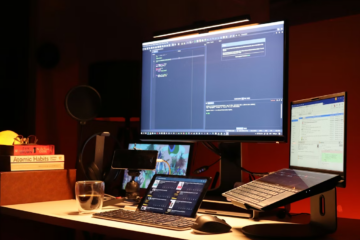
As of late, it seems like MSP remote work is gaining a tremendous amount of popularity, while office work is looked down upon more and more.
There are some great advantages to working from an office. The sense of camaraderie, the water cooler banter, and being compelled to leave your home every day can be great for your mental health.
Nonetheless, if you pay close attention, you’ll notice that these really have nothing to do with your work or productivity. They’re all social aspects that could be easily made up for by just… wait for it… hanging out with people in real life. Using the excuse that you can’t “make yourself do this unless” to squeeze one win for the on-site work is more telling than people realize.
Don’t get us wrong, there are still some jobs that have to be done on-site, either because of the security or because the work requires you to be physically there. However, this is not the case for most of the service industry, it’s definitely not the case for most of the IT industry, and it’s especially not the case with MSP.
Constant Interruptions Kill Flow

There’s a certain rhythm to deep work, and once you’re in it, the last thing you want is someone tapping your shoulder asking if you’ve “got a minute.” In an office, that kind of thing happens constantly. You’re in the middle of diagnosing a networking issue, and suddenly someone walks up to ask about a printer. That quick distraction might seem harmless, but it pulls you out of the zone and makes it way harder to refocus.
When you’re doing MSP remote work, you actually have a real shot at protecting your flow. You can pause notifications, close unnecessary tabs, and give your full attention to the problem at hand. No one’s breathing down your shoulder or hovering until you give them an answer. It’s your time—yours to manage—and it shows in the quality of the work.
Office environments often prioritize visibility over productivity. Just because someone’s at their desk doesn’t mean they’re getting anything done. In contrast, remote techs get to structure their day around what works for them. You’re not stuck reacting to every interruption—you’re solving real issues, the way MSP help desk jobs were meant to be handled.
Let’s not pretend Slack and Teams aren’t noisy. The difference is that remote workers can mute or step away when they need deep focus. There’s no “mute” button for noisy coworkers in the office. Remote setups finally let techs take back their attention—and that’s a big part of why they love it.
Communities Drain Time and Energy
No one takes an IT help desk job thinking, “I can’t wait to spend two hours a day stuck in traffic.” The work is supposed to be about solving technical problems, not battling rush hour. And yet, when you’re forced into an office, that’s what happens—huge chunks of your day wasted before you even log in.
The commute doesn’t just eat time—it drains mental energy. You could’ve spent that time sleeping a little longer, grabbing a real breakfast, or reviewing system updates. Instead, you’re white-knuckling the steering wheel, just trying to make it to work on time. By the time you’re there, half your battery’s already gone.
MSP schedules rarely fit the neat 9-to-5 mold anyway. Tickets come in at odd hours. Clients call in the evenings. So forcing a rigid commute on techs who already work flexible hours makes no real sense. Remote workforce management for MSP teams fixes this imbalance by letting people work smarter, not harder.
You see, when people work remotely, they start their day fresh, not stressed. They can tackle tasks earlier, stay focused longer, and ultimately deliver better results. In a job built around precision and efficiency, that extra mental energy makes a real difference.
The Office Doesn’t Really Improve Collaboration

According to one MSP staffing company, there’s this romantic idea that collaboration magically happens in the office, but most of the time it’s just background noise. You’re standing behind someone’s chair trying to help them troubleshoot a server issue, and half the time, you both end up frustrated. Screen sharing, on the other hand, actually gets things done, and nobody needs to hover awkwardly.
Modern collaboration tools were literally designed for remote setups. Ticketing platforms, real-time project boards, chat apps—they don’t care where you are. Remote troubleshooting and collaboration aren’t just possible—they’re usually better. MSP help desk teams, in particular, thrive when they can quickly pass updates back and forth without the distractions of an open-plan office.
Asynchronous communication has huge advantages. You send an update, the other person thinks it through, and you reconnect with a real solution. That beats three people talking over each other in a rushed conversation by a mile. Clarity goes up, and mistakes go down.
You see, when the tools are solid, collaboration happens naturally. Zoom, Slack, Teams—they make it easy to connect when needed. Remote teams aren’t less collaborative; they’re just more intentional about when and how they communicate. That’s a major upgrade, not a compromise.
Flexibility Boosts Performance
People from an agency providing an outsourced MSP staffing company, not everyone is built for the standard 9-to-5. Some MSP techs are sharper at night. Others prefer early mornings. One of the biggest perks of MSP remote work is that it allows people to structure their day around when they’re at their best, not when they’re forced to appear busy.
When you’re allowed to work around your own rhythm, productivity skyrockets; if you’re tired, you rest. If you’re on a roll, you power through. You’re not stuck watching the clock or pretending to be engaged during some mid-afternoon energy crash. Flexibility makes a real difference—and the ticket close rates prove it.
The whole “butts in seats” mentality vanishes. In the office, showing up early or looking stressed sometimes gets mistaken for hard work. With remote setups, you’re judged on output—what you fix, what you solve, and how well you do it. That’s the only thing that matters in MSP help desk jobs.
When you’re not spending half your energy dealing with a rigid schedule, you’re free, actually, to care about your work. You solve tougher issues, you troubleshoot smarter, and you show up with your A-game because you’ve been given the room to operate like a professional, not a schoolkid waiting for the bell.
Results Matter More than Appearances

Clients don’t care if you were in pajama pants when you fixed their remote desktop connection. They care that it’s fixed, and it’s fixed fast. That’s the heart of every MSP help desk job—the outcome, not the optics. Nobody’s asking what you looked like while solving a significant outage.
The office can sometimes reward the wrong things. Being seen early or staying late doesn’t always mean you’re getting anything done. Remote work forces the conversation back to real results. Are you solving issues? Are you helping clients? That’s what matters, and that’s what good MSPs are starting to recognize.
Techs who work remotely often invest in better gear. Standing desks, high-end monitors, and ergonomic setups – when you’re home, you can optimize your workspace instead of dealing with worn-out chairs and flickering office lights. That investment pays off in better, more consistent output.
Remote workforce management for MSP companies isn’t just about making people happy. It’s about driving better business outcomes. If clients are happy, if systems are running smoothly, if metrics are being hit, then it’s working. And all of that can happen without a single water cooler conversation.
Wrap Up
MSP remote work gives techs exactly what they need to do their jobs better—focus, flexibility, and freedom from unnecessary distractions. You see, when the results improve and the clients stay happy, there’s no point forcing people back into cubicles just for the sake of appearances. Remote workforce management for MSP teams isn’t just working – it’s thriving.



0 Comments